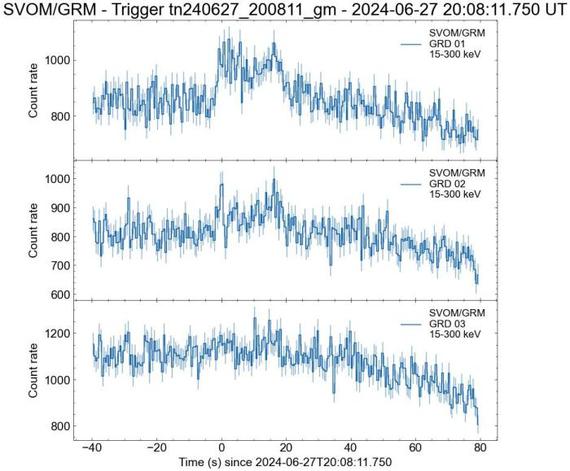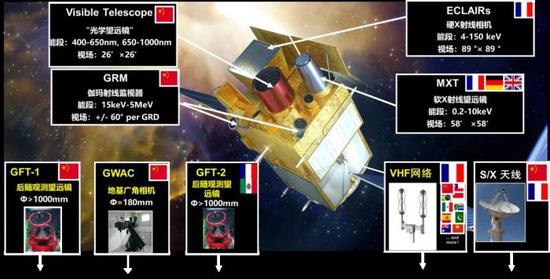China-France Astronomy detects three gamma-ray bursts
(ECNS) – Having completed its payload activation test within two weeks of launch, the China-France Astronomy Satellite identified three gamma-ray bursts (GRBs), coordinates of which have been released to the international Gamma-ray Coordinates Network (GCN), the Chinese Academy of Sciences (CAS) announced on Monday.
The Satellite, also known as the Space-based Multiband Astronomical Variable Object Monitor (SVOM), was launched on June 22. The onboard Gamma-Ray Burst Monitor (GRM), developed by the CAS Institute of High Energy Physics, was activated on June 24.

It captured the first GRB (designated GRB240627B) on June 27, which represents the first scientific detection result of the SVOM in orbit. Later, the GRM detected the second GRB (GRB240629A) on June 29, and the third (GRB240702A) on July 2.
The light curve of this GRB matched the observations of the “GECAM-C” space telescope onboard China’s Chuangxin X satellite, as well as results from the international Fermi Satellite detector.
The results of three GRBs have been submitted to the GCN, showing the high-precision triggering and detection capabilities of the SVOM’s GRM and contributing to settlement of major questions in fundamental science.
As an international cooperation project between China and France in the field of space science, the SVOM is currently the world’s most capable satellite for multi-band comprehensive observation of GRBs.
The satellite, developed by the Innovation Academy for Microsatellites of the Chinese Academy of Sciences, integrates four payloads developed by both Chinese and French teams: the GRM, ECLAIRs, MXT, and the Visible Telescope (VT), covering observation bands from high-energy to near-infrared.

During in-orbit testing, the satellite platform functioned normally, establishing real-time connections with over 40 Very High Frequency (VHF) ground communication stations. All four payloads have completed their activation tests.
From June 22 to 24, the satellite completed tests for the platform, satellite-ground control, data transmission, and VHF communication links. The platform’s status remained stable, and all subsystems performed according to mission requirements, meeting the conditions for payload testing.
The VT payload, developed by the CAS Xi’an Institute of Optics and Precision Mechanics, was activated on June 24. It had completed motion mechanism, imaging, and flat-field calibration tests by June 27. Results indicated that the VT’s motion mechanism, detector imaging, and calibration were all functioning normally. The VT is currently in a post-orbit contamination protection mode, and performance tests will commence once decontamination is complete.

The ECLAIRs and MXT payloads, led by the French Space Research Center, were activated on June 25. They entered configuration mode on July 1 as per the test plan, with self-test procedures for the payloads expected to be completed in the coming days, followed by a trial operation phase.
Moving forward, the SVOM will continue its in-orbit testing according to plan at CAS the Comprehensive Operations Control Center for Scientific Satellites. The focus will be on completing payload calibration and operational tests, with the satellite expected to enter the scientific mission observation testing phase by August, contributing to the detection and research of GRBs and other space astronomical phenomena.

